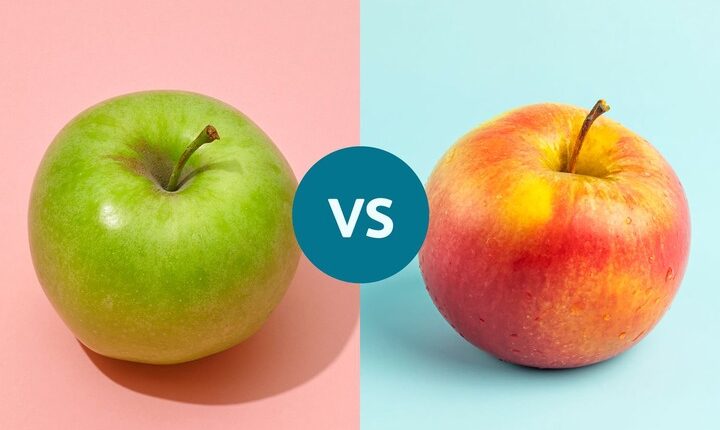EXCLUSIVE:: Green Apples vs. Red Apples: Which One Is Healthier?
Key Takeaways
- Red and green apples are healthy and contain fiber, vitamin C, and antioxidants.
- Regardless of color, apple skin contains high levels of antioxidants and should be eaten alongside the apple flesh to promote health.
Red and green apples are healthy and have similar nutritional profiles. While they have minor differences in carbohydrate and antioxidant content, neither is more nutritious. Choosing the “better” option comes down to personal preference.
Key Differences Between Red and Green Apples
Both red and green apples can be part of a healthy diet and contain similar fiber and vitamin C levels.1 However, they have subtle differences in taste, calories, and antioxidant content.
- Taste sweet
- Have slightly more calories and carbs
- Contain antioxidants from anthocyanins
- Taste tart
- Have slightly less calories and carbs
- Contain antioxidants from chlorophyll
- Green apples: Green apples may be slightly lower in calories and carbohydrates than red apples, evidenced by their tart taste.2 However, the difference is minimal and doesn’t mean they’re healthier than red apples.
- Red apples: Red apples contain higher levels of anthocyanins, which have antioxidant properties and help fight off cell damage from free radicals. However, green apples also contain antioxidants from different sources, such as chlorophyll.3
- Apple skin: Apple skin, of both red and green varieties, contains significantly more antioxidants than the flesh. If you’re seeking health benefits, eat your apples with the skin on (no matter their color).3
What Creates an Apple’s Color?
An apple’s color is created by plant pigments found in many other fruits and vegetables.4 In addition to providing apples with their color, plant pigments contain antioxidants, which are responsible for numerous health benefits.
The three main pigments that affect apple color and their health effects are as follows:5
- Anthocyanins: Red, blue, or purple pigment; helps prevent cardiovascular disease (CVD), some cancers, diabetes, some metabolic diseases, and infection.6
- Carotenoids: Yellow, orange, or red pigments; help reduce oxidative stress and protect the body against chronic diseases, such as CVD, cerebrovascular diseases, eye diseases, osteoporosis, and cancer.7
- Chlorophylls: Green pigment; helps reduce the risk of cancer, skin diseases, CVD, hormonal imbalances, gastrointestinal issues, reproductive and urinary conditions, respiratory system disorders, musculoskeletal disorders, and liver diseases.8
These pigments create different apple colors depending on their levels. Other factors that affect apple color include:5
- Age
- Apple genetics
- Crop load
- Environmental factors like light and temperature
- Plant nutrition
- Root health
:max_bytes(150000):strip_icc():format(webp)/VWH-Cold-Brew-vs-Iced-Coffee-template-2-99316857955046aaa4109a21c2610dee.jpg)
Cold Brew vs. Iced Coffee: Which One Is Healthier For You?
Health Benefits of Apples
Regardless of color, apples have numerous health benefits, ranging from boosting your immune system to promoting gut and heart health. Some of these health benefits include:
- Improves cholesterol levels9
- Reduces inflammation
- Lowers the risk of heart disease10
- Lowers the risk of certain cancers11
- Supports healthy digestion due to fiber
- Reduces the risk of osteoporosis12
- Protects against cell damage1
- Helps manage weight13
Eating red or green apples can be part of a healthy diet. The best apple is the one you enjoy the taste and texture of, and will eat regularly.
Varieties of Red and Green Apples
To help you choose your next apple, consider the following varieties of red and green apples.
Red apple varieties include:144
- Empire
- Fuji
- McIntosh
- Red delicious
- Royal gala
Green apple varieties include:4
- Golden delicious
- Granny smith
- Orin
Some apples, like Pink Lady and Honeycrisp, fall somewhere in the middle and have both light red and green pigments.
Which One Tastes Better?
Each variety of apple has its own slightly differing flavor profile, but color can also affect how you perceive a food to taste. Generally, red apples are considered sweeter, and green apples are more tangy and crispy.
In one study, people ate the same variety of apple, artificially dyed shades of yellow, green, red, and blue. The researchers found that people enjoyed the dark red apples least, even though the apples should have tasted the same.15
People perceived the darker red apples to be less crispy and more astringent than the yellow and green apples.15
Limited studies compare people’s reactions to true red or green apples. The decision comes down to personal preference.

